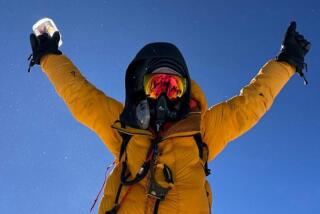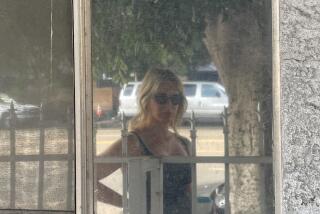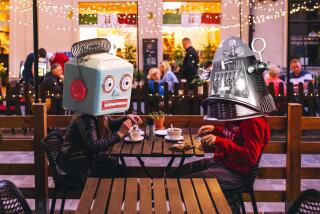‘We’re not out to have a party. We’re talking rationing.’
- Share via
Occasionally, those who live and work in the Valley leave it to share their vision with the world outside.
That is what Jeffrey Stevens was up to one morning recently when he walked past a grass-lined sidewalk on Wilshire Boulevard and stepped into the newly refinished lobby of the Art Moderne headquarters of a big insurance company.
Stevens works for Survivor Industries Inc. of Agoura, a firm founded by a man named Harold Wallace, who concluded after living through the 1971 earthquake that he might need more than luck to survive the next one and decided to do something about it.
The company packages a kit designed to carry several people through the lean hours after the next big earthquake or similar disaster.
The Survivor Pak, as he calls it, comes in a large gadget bag of metallic gray with fluorescent orange handles. It has everything that three survivors would need to last six days and to medicate or dispose of their fellow workers who were not so lucky.
Stevens had an appointment to pitch the Pak to mid-level manager at the insurance company.
The manager consented to the presence of a reporter but asked to consult upper-management on the use of the company name, not knowing whether the notice would have a positive or a negative effect.
Stevens, on the other hand, was happy to expose himself to the full force of publicity on the theory that it might bring someone a step closer to survival. He was demure about his role.
“I don’t want to be selling disaster,” he told the reporter. “I’ve gone past the point of convincing people of the need. I’ve got the solution to the disaster.”
The young client led Stevens through a large office bay where perhaps 100 people raised a lively clatter at computer terminals. They sat across from each other at a long conference table.
Stevens was in insurance before he got into disasters. So it was with some actuarial self-assurance that he briefed his client on the suffering those employees would experience should the next earthquake sever water pipes, power cables, phone lines and freeways. They would be trapped with one another for several days.
He guessed that there were 600 to 800 people in the building.
“Right there, we’re in the neighborhood of 4,300 gallons of water,” he said, calculating an average home use of five gallons or more a day. “That’s ridiculous. You’d have to build a small swimming pool.”
Stevens unzipped the bag. He took out a small, aluminum-coated pouch that looked like seasoning from a macaroni package but was fat and wiggled with liquid inside. It thudded against the table when he tossed it.
“We’re not out to have a party,” he said. “We’re talking rationing. That’s a half-day’s ration of drinking water.”
Next, Stevens produced a solid cube about three inches along each edge wrapped in blue metallic paper.
“When it comes to food, what you’re looking at here is a three-day supply,” he said. “Five-year shelf life. We’ve got some companies that are talking about donating it to the poor after that. High carbohydrate so it doesn’t induce thirst. It’s a very pleasant-tasting biscuit. It’s a biscuit-glucose combination.
Stevens unfolded a color picture of the contents of the Survivor Pak. Besides the food, there were radios, flashlights, medical kits, a survival knife and a 50-foot rope. The price: $129.90 for a three-man kit. He said that was the original kit, for consumers, not for businesses.
“What we started out with was a Rolls-Royce you’re only going to drive once, if you’re going to drive at all, and then throw it away,” he said.
“You can’t justify that to upper management. You don’t need a hunting knife here. We’ve modified the unit, pulled out the outdoor stuff, pulled out the tools, made it an immediate response kit...$9.19 per person, food and water.”
He said lots of companies buy just the food and water first. Then, as budgets allow, they second-tier essentials such as the “energy blanket,” an all-purpose cover made of space-age materials.
“The manufacturer guarantees that it not only retains 80% of its heat, it also supports 250 pounds of weight. You’ve got a stretcher.”
Besides that, he said, it could be strung up on the 50-foot rope around the latrine to provide a semblance of privacy. And better than that.
“In the event of fatalities, the disaster agencies suggest you set up a morgue area---- it’s a body bag. Moderate as it is, baking soda acts as a moderate deodorant. You’ve got your morgue area.” The baking soda is included.
“Right there, that completes your system,” Stevens said. “Then it’s a matter of how far you want to go. That’s it.”
The company officer said he was impressed with the plan and would go to bat for it. He asked for samples of the food and water, promising to return them.
“No problem,” Stevens said. “Eat it. Have a drink on me.”
Stevens then retired to the Valley to await the company’s decision.
Two days later the young man called. He said upper management had turned the proposal down. It decided to rely on bottled water and canned food from the cafeteria.
It had also decided that any mention of its name could do no good. It wished to remain anonymous.
More to Read
Sign up for Essential California
The most important California stories and recommendations in your inbox every morning.
You may occasionally receive promotional content from the Los Angeles Times.











